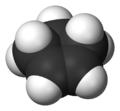Cyclopentene
| |||

| |||
| Names | |||
|---|---|---|---|
| Preferred IUPAC name
Cyclopentene | |||
| Identifiers | |||
3D model (JSmol)
|
|||
| ChEBI | |||
| ChEMBL | |||
| ChemSpider | |||
| ECHA InfoCard | 100.005.030 | ||
PubChem CID
|
|||
| UNII | |||
CompTox Dashboard (EPA)
|
|||
| |||
| |||
| Properties | |||
| C5H8 | |||
| Molar mass | 68.11 g/mol | ||
| Density | 0.771 g/cm3 | ||
| Melting point | −135 °C (−211 °F; 138 K) | ||
| Boiling point | 44 to 46 °C (111 to 115 °F; 317 to 319 K) | ||
| Hazards | |||
| NFPA 704 (fire diamond) | |||
| Flash point | −29 °C (−20 °F; 244 K) | ||
| Related compounds | |||
Related compounds
|
Cyclopentadiene Cyclobutene | ||
Except where otherwise noted, data are given for materials in their standard state (at 25 °C [77 °F], 100 kPa).
| |||
Cyclopentene is a chemical compound with the formula (CH2)3(CH)2. It is a colorless liquid with a petrol-like odor. It has few applications, and thus is mainly used as a minor component of gasoline, present in concentrations of less than 1%.[1][2] It is one of the principal cycloalkenes.
History and synthesis
[edit]Cyclopentene was first prepared by Carl Gärtner in 1893 from iodocyclopentane with potassium hydroxide. He named it pentamethenylene (German: Pentamethenylen).[3]
Cyclopentene is produced industrially in large amounts by steam cracking of naphtha. In the laboratory, it is prepared by dehydration of cyclopentanol.[4] Substituted cyclopentenes are the product of the vinylcyclopropane-cyclopentene rearrangement.[5]
It can also be produced by the catalytic hydrogenation of cyclopentadiene.[6]
Reactions
[edit]The polymerization of cyclopentene by Ziegler-Natta catalysts yields 1,3-linkages, not the more typical 1,2-linked polymer.[7]
Palladium-catalyzed hydrocarboxylation of cyclopentene gives cyclopentanecarboxylic acid:[8]
- C5H8 + CO + H2O → C5H9CO2H
References
[edit]- ^ Dieter Hönicke; Ringo Födisch; Peter Claus; Michael Olson (2002). "Cyclopentadiene and Cyclopentene". Ullmann's Encyclopedia of Industrial Chemistry. Weinheim: Wiley-VCH. doi:10.1002/14356007.a08_227. ISBN 978-3527306732.
- ^ "Hydrocarbon Composition of Gasoline Vapor Emissions from Enclosed Fuel Tanks". nepis.epa.gov. United States Environmental Protection Agency. 2011.
- ^ Gärtner, Carl (January 1893). "Das Pentamethenylen und sein Dibromür". Justus Liebigs Annalen der Chemie. 275 (2–3): 331–332. doi:10.1002/jlac.18932750217. ISSN 0075-4617.
- ^ B. B. Corson, V. N. Ipatieff (1939). "Cyclohexylbenzene". Organic Syntheses. 19: 36. doi:10.15227/orgsyn.019.0036.
- ^ Baldwin, John E. (2003). "Thermal Rearrangements of Vinylcyclopropanes to Cyclopentenes". Chemical Reviews. 103 (4): 1197–212. doi:10.1021/cr010020z. PMID 12683781.
- ^ D. Hönicke, R. Födisch, P. Claus, M. Olson: Cyclopentadiene and Cyclopentene, in: Ullmanns Enzyklopädie der Technischen Chemie 2002, Wiley-VCH, Weinheim.
- ^ Collins, Scott; Kelly, W. Mark (1992). "The microstructure of poly(cyclopentene) produced by polymerization of cyclopentene with homogeneous Ziegler-Natta catalysts". Macromolecules. 25 (1): 233–7. Bibcode:1992MaMol..25..233C. doi:10.1021/ma00027a039.
- ^ Sang, Rui; Kucmierczyk, Peter; Dühren, Ricarda; Razzaq, Rauf; Dong, Kaiwu; Liu, Jie; Franke, Robert; Jackstell, Ralf; Beller, Matthias (2019). "Synthesis of Carboxylic Acids by Palladium‐Catalyzed Hydroxycarbonylation". Angewandte Chemie International Edition. 58 (40): 14365–14373. doi:10.1002/anie.201908451. PMID 31390131. S2CID 199466915.
External links
[edit] Media related to Cyclopentene at Wikimedia Commons
Media related to Cyclopentene at Wikimedia Commons




